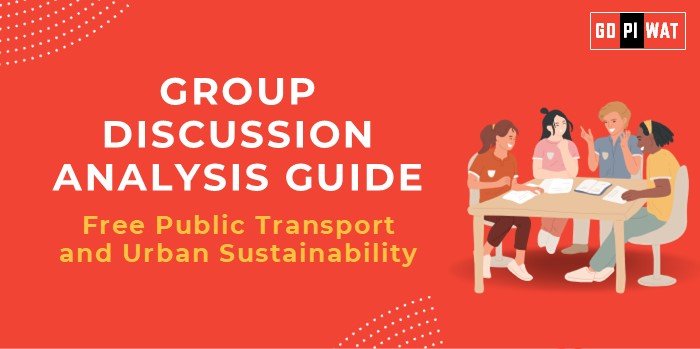🚍 Group Discussion (GD) Analysis Guide: Free Public Transport and Urban Sustainability
🌍 Introduction to the Topic
Opening Context: “As climate change intensifies, urban emissions from private vehicles remain a significant contributor to global greenhouse gas emissions, prompting debates on whether free public transport could offer a sustainable solution.”
Background: Many countries, such as Luxembourg and Estonia, have introduced free public transport as a step towards reducing emissions, easing urban congestion, and promoting equity in mobility.
📊 Quick Facts and Key Statistics
- Transport Emissions: Road transport accounts for 21% of global CO2 emissions (IEA, 2023).
- City Programs: Over 100 cities globally have implemented free public transport to reduce urban pollution (C40 Cities Report, 2023).
- Cost Implications: Tallinn, Estonia, reported a 14% increase in public transport ridership post-free transport policy (2022).
- Global Vehicle Ownership: Private car ownership exceeds 1.45 billion globally, with significant growth in urban areas (World Bank, 2023).
👥 Stakeholders and Their Roles
- Government Authorities: Design and implement free transport systems.
- Private Sector: Provide infrastructure and technological solutions.
- Citizens: Drive behavioral change by adopting public transport.
- Environmental Organizations: Advocate for sustainable mobility solutions.
- Global Institutions: Fund and research sustainable transport initiatives.
🎯 Achievements and Challenges
- Achievements:
- Emission Reductions: Luxembourg reported lower urban pollution levels.
- Equity: Increased access for economically disadvantaged groups.
- Traffic Congestion: Tallinn observed a 15% decline in private car usage.
- Challenges:
- Financial Sustainability: Managing costs without ticket revenues.
- Overcrowding: Increased ridership strains services.
- Scope: Limited impact on rural connectivity.
Global Comparisons: Estonia leads with free public transport, while Japan focuses on pricing efficiency. Delhi’s free public bus travel for women boosted ridership by 10% in 2021.
💬 Structured Arguments for Discussion
- Supporting Stance: “Free public transport can lead to a significant reduction in urban emissions and promote sustainable living.”
- Opposing Stance: “Financial constraints and service inefficiencies might outweigh environmental benefits.”
- Balanced Perspective: “While the idea offers potential environmental gains, a hybrid model with subsidies might be more viable.”
📢 Effective Discussion Approaches
- Opening Approaches:
- Impactful Statistics: “Road transport emissions contribute 21% to global CO2, necessitating bold interventions like free public transit.”
- Global Benchmarks: “Tallinn’s free transport reduced private car usage by 15%.”
- Counter-Argument Handling:
- Address Funding Concerns: “Dedicated environmental taxes or congestion charges can offset costs.”
- Infrastructure Challenges: Propose phased implementation to ensure smooth adaptation.
🛠 Strategic Analysis: SWOT
- Strengths: Reduction in emissions, equitable access, urban congestion mitigation.
- Weaknesses: Financial sustainability, limited rural impact, potential overcrowding.
- Opportunities: Public-private collaborations, integration with smart transport systems.
- Threats: Opposition from private transport operators, political pushback.
🎓 Connecting with B-School Applications
- Real-World Applications: Explore sustainable transport policy frameworks for urban management projects.
- Sample Interview Questions:
- “How would you balance economic and environmental priorities in free public transport policies?”
- “What are alternative models to incentivize public transport usage?”
- Insights for Students:
- Research the intersection of sustainability and urban planning.
- Analyze models blending subsidies with service optimization.


